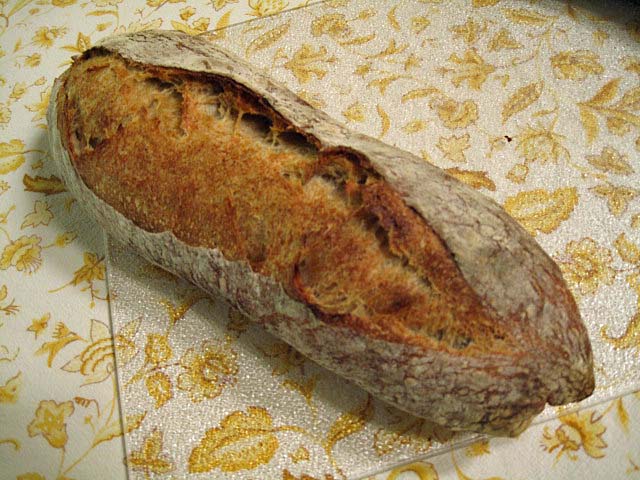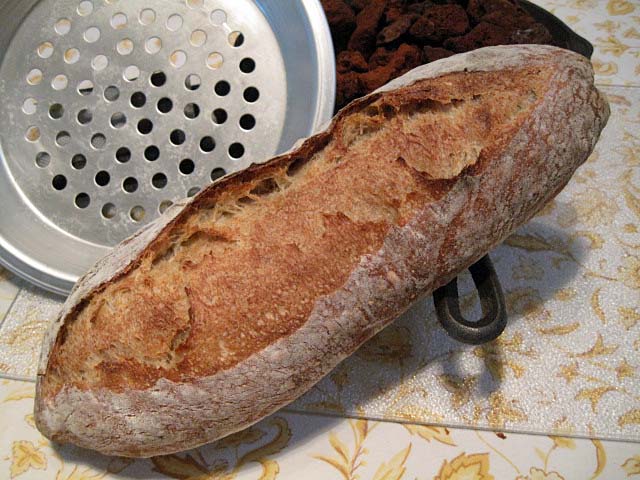
The "San Joaquin Sourdough" is my own recipe. It evolved through multiple iterations from Anis Bouabsa's formula for baguettes. Most of my deviations developed in discussion on TFL with Janedo, who first suggested adding sourdough starter and rye, and, then, leaving out the baker's yeast and making it as a "pure" pain au levain.
I have tried many modifications of ingredients and procedures. The current formula uses the ingredients specified below.
Those who have followed the evolution of this bread will note that I have increased the levain from 20 to 30 (baker's) percent. I have also switched from a 75% hydration levain to a 100% hydration levain, reducing the water added to the dough to keep the overall dough hydration about the same.
Originally, all gluten development was by the “stretch and fold in the bowl” method. I have added a couple folds on the board and lengthened the bulk fermentation prior to cold retarding the dough.
These changes result in a somewhat tangier bread. I don't think they have changed the crust or crumb structure noticeably.
I made two other modifications of my procedures for today's bake: First, I employed the oven steaming method recommended for home bakers by The San Francisco Baking Institute.
The oven is not pre-steamed (before loading the loaves). A cast iron skillet filled with steel pieces (nuts and bolts, rebar pieces) is pre-heated in the oven along with two baking stones. One stone is placed on a rack above the stone and rack on which the loaves will be loaded. When the loaves are loaded, a perforated pie tin filled with ice cubes is set atop the skillet. As the ice melts, water drips through the perforations and turns to steam when it hits the metal pieces.
I deviated from the SFBI-prescribed method in two particulars: I used only a single baking stone, and my cast iron skillet was filled with lava rocks rather than steel pieces.

My second procedure modification was to open the oven door for a few seconds every 5 minutes during the final 15 minutes of the bake. This was to “vent” the steam rising from the loaves themselves in the hope this would result in a crust that stays crisp longer. It did result in less softening of the crust as the bread cooled. Methods to vent the oven and dry the crust during the last part of the bake warrant further exploration.
|
Ingredients
|
|
|
Active starter (100% hydration)
|
150 gms
|
|
KAF All Purpose flour
|
450 gms
|
|
BRM Dark Rye flour
|
50 gms
|
|
Water
|
360 gms
|
|
Sea Salt
|
10 gms
|
Procedures
Mixing In a large bowl, mix the active starter with the water to dissolve it. Add the flours and stir to form a shaggy mass. Cover tightly and let rest (autolyse) for 20-60 minutes.
Sprinkle the salt over the dough. Using a plastic scraper or silicon spatula, stretch and fold the dough 30 times, rotating the bowl 1/5 turn between each stroke. Cover tightly. Repeat this stretch and fold procedure 3 times more at 30 minute intervals.
Fermentation After the last series of stretches and folds, scape the dough into a lightly oiled 2 quart/2 liter container and cover tightly. (I use a 2 quart glass measuring pitcher with a tightly fitting plastic lid manufactured by Anchor Glass.) Ferment at room temperature for 90 minutes with a stretch and fold after 45 minutes, then place in the refrigerator and leave it there for 21 hours.
Dividing and Shaping Take the dough out of the refrigerator and scrape it gently onto a lightly floured work surface. Gently pat it into a rectangle. Divide as desired or leave in one piece. To pre-shape for a bâtard, fold the near edge up just past the center of the dough and seal the edge by gently pressing the two layers together with the ulnar (little finger) edge of your hand or the heel of your hand, whichever works best for you. Then, bring the far edge of the dough gently just over the sealed edge and seal the new seam as described.
Cover the dough with plastic wrap and/or a kitchen towel and let it rest for about 60 minutes, with the seams facing up. (The time will depend on ambient temperature and how active your starter is. The dough should have risen slightly, but not much.)
To shape a bâtard, fold the near edge of the dough and seal the edge, as before. Now, take the far edge of the dough and bring it towards you all the way to the work surface and seal the seam with the heel of your hand. Rotate the loaf gently toward you 1/4 turn so the last seam you formed is against the work surface and roll the loaf back and forth, with minimal downward pressure, to further seal the seam. Then, with the palms of both hands resting softly on the loaf, roll it back and forth to shape a bâtard. Start with both hands in the middle of the loaf and move them outward as you roll the loaf, slightly increasing the pressure as you move outward, so the bâtard ends up with the middle highest and the ends pointed .
Preheating the oven One hour before baking, place a baking stone on the middle rack and put your steaming apparatus of choice in place. Heat the oven to 500F.
Proofing After shaping the loaf, transfer it to parchment paper liberally dusted with semolina or a linen couche. Cover the loaf with plastic wrap and a kitchen towel or a fold of the linen. Proof until the loaf has expanded to about 1-1/2 times it's original size. (30-45 minutes) Do not over-proof, if you want good oven-spring and bloom!
Baking Pre-steam the oven, if desired.
Slip a peel or cookie sheet under the parchment paper holding the loaf or transfer to a peel, if you used a couche. Score the loaf. (For a bâtard, hold the blade at about a 30 degree angle to the surface of the loaf. Make one swift end-to-end cut, about 1/2 inch deep.)
Transfer the loaf (and parchment paper, if used) to the baking stone. Steam the oven. Turn the oven down to 460F.
After 12-15 minutes, remove the loaf pan and your steaming apparatus from the oven. Rotate the loaf 180 degrees, if it is browning unevenly. Close the oven door.
Bake for another 12-15 minutes, then remove the loaf and place on a cooling rack. Check for doneness. (Nice crust color. Internal temperature of at least 205F. Hollow sound when you thump the bottom of the loaf.) If necessary, return to loaf to the oven to bake longer.
Cooling Cool on a rack for two hours before slicing.

David
Submitted to YeastSpotting